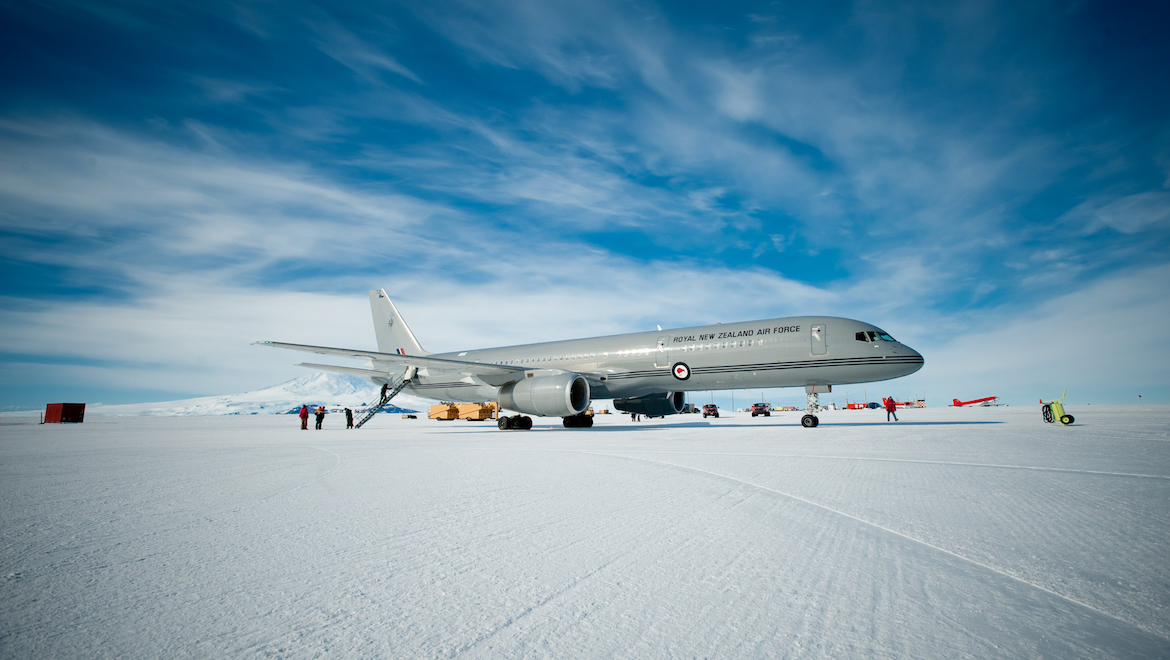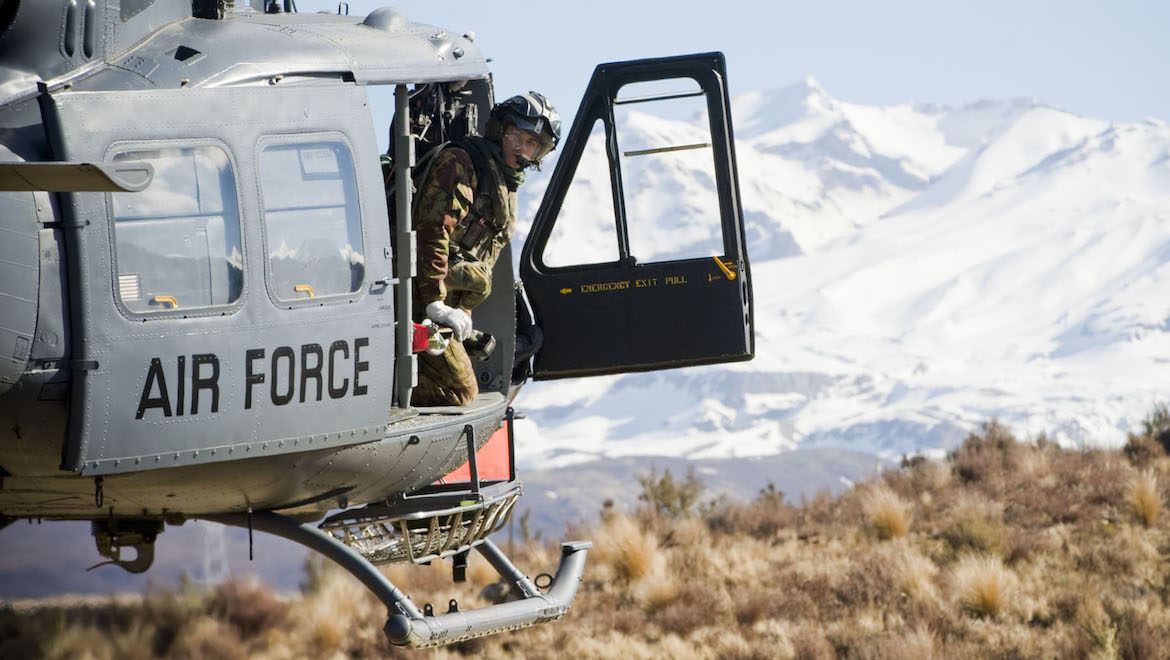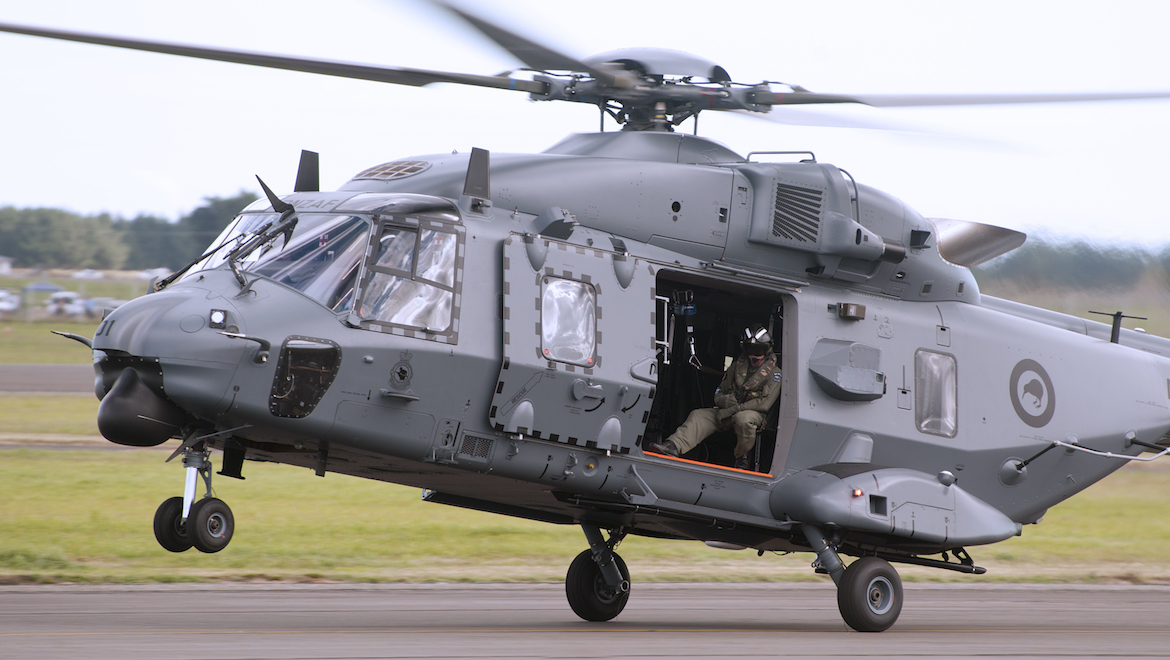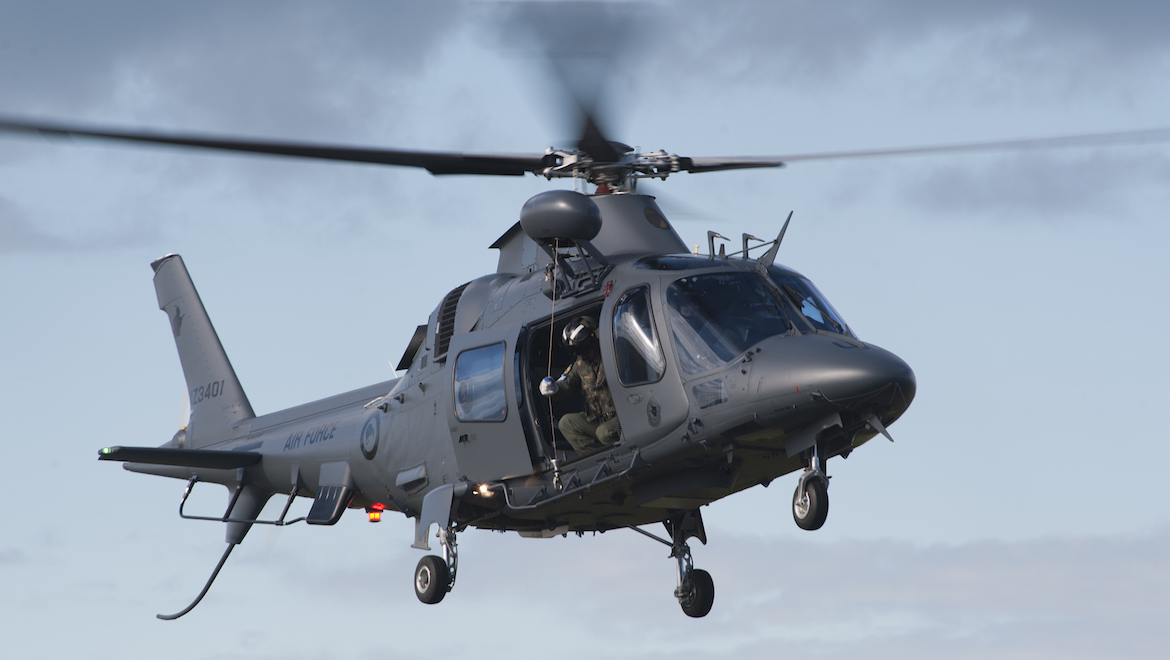This story from the Australian Aviation archives is from June 2012, when Phillip Mckinnon wrote about the 75th anniversary of the Royal New Zealand Air Force.

Ever since a Chinese emperor formed the world’s first standing army, the fortunes of all subsequent military organisations have waxed and waned in line with the needs of their political masters, not to mention the depth of pocket of the taxpayers required to fund these undertakings.
The fortunes of the Royal New Zealand Air Force (RNZAF) have been no different. Formed in 1936, the RNZAF grew to its peak during World War 2 with large numbers of personnel and aircraft serving in both Pacific and European theatres.
At its peak in the Pacific, the RNZAF had 34 squadrons of which 25 were deployed overseas in action against the Japanese. At home, the RNZAF operated several mixed transport and communications squadrons, a flight of Short Sunderlands and almost 1,000 training aircraft which, as well as meeting its own needs, turned out aircrew for the RAF under the Empire Air Training Scheme.
In Europe, most RNZAF personnel served with RAF units, but under “Article XV” six NZ squadrons were attached to RAF formations and the Fleet Air Arm. During the war these squadrons operated most types of RAF aircraft. By 1945, the RNZAF had over 41,000 personnel, including over 10,000 aircrew who served with the RAF in Europe and Africa.
The end of hostilities saw an inevitable and dramatic reduction in the size to meet the needs of the new Cold War strategic environment. But during the 1960s the RNZAF was re-equipped with what is still its current frontline fleet of Hercules, Orion, Iroquois – and of course the Skyhawk.
The end of Cold War tensions saw a further fall in the size of the RNZAF and a refocusing of its capabilities to meet the new strategic situation.

The road to today’s RNZAF
In a move that was to change its focus and define the RNZAF as we see it today, Helen Clark’s 2001 Labour government decided that maintaining fast jets was beyond the means of the country and also out of step with her government’s view of the security needs of New Zealand and the wider Asia Pacific – so the capability was axed.
The decision was taken as part of a wider review of the New Zealand Defence Force (NZDF), which became mainly a land-based force supported by the Navy and Air Force. The New Zealand Army was re-equipped with LAV III armoured personnel carriers and the Navy given a sealift capability to transport them.
This move was effected by removing the RNZAF’s A-4K Skyhawk air combat capability and cancelling the purchase of 28 Block 15 F-16 Fighting Falcons. With no more fast jets, Nowra-based No 2 Squadron and the main strike squadron, Ohakea-based No 75 Skyhawk Squadron, were disbanded.
With no need to train fast jet pilots the Aermacchis of No 14 Squadron also were withdrawn. Unsurprisingly, many of the fast jet pilots, looking to employ the excellent training the New Zealand taxpayer had provided them, went to greener pastures with the RAAF and RAF.
Concurrently, Project Sirius, the upgrade of the RNZAF’s six Lockheed P-3K Orion maritime patrol aircraft, was terminated as part of the government’s sweeping overhaul of defence priorities.
By 2003, the RNZAF was reduced to a total of 53 aircraft and 2,523 personnel including civilian employees. The result was low morale, high attrition rates and uninspiring recruiting figures.
However, despite this trying time the RNZAF came through it well and was soon looking to the future.
As well as the downsizing, the need to either replace or extend the service life of the remaining now 40-year-old aircraft was becoming pressing. However, in a first for the Lockheed Orion, the RNZAF’s six-strong P-3K Orion fleet underwent a highly successful structural life extension.
At the time no-one, not even Lockheed Martin, had rewinged a P-3B Orion, the model developed into the P-3K by the RNZAF, with P-3C wings, the only new ones then available. An RNZAF team worked with Lockheed Martin to develop the successful project – at reportedly less than a tenth the cost of new aircraft.
With a new lease of structural life the decision was taken to modernise the Orions’ mission systems and in 2005 the first L-3 P3K Orion arrived at L-3 Communications in Texas for a systems upgrade.
To overcome the obsolescence problem facing the Hercules fleet it was decided to extend its structural life by 15 years. This followed a study of structural and airworthiness issues as well as the communications, navigation, surveillance – air traffic management (CNS-ATM) upgrade required if the aircraft were to be internationally CNS-ATM airspace compliant. Subsequently, L-3 Systems Spar Aerospace won a contract in 2005 for the refurbishment and upgrade.
At the same time, it was decided to replace the RNZAF’s ageing, unreliable Boeing 727-22QCs with two Boeing 757-200s. But as the type was not built with a freight door option, standard passenger models were bought then modified to freight/passenger capability with a cargo door installed and the floors strengthened.
The rotary-wing fleet was every bit in need of upgrading so the ageing, obsolete Iroquois are being replaced with new NH Industries NH90 helicopters, while the vintage Bell Sioux used for training are being replaced with AgustaWestland A109s for training and light utility roles.

Today’s RNZAF
In the 75 years since it was formed the RNZAF finds itself in the process of becoming a much more modern and capable force than it has been since the 1960s. With upgrade and acquisition programs in place and the government’s first White Paper on Defence in over a decade delivered in late 2010, the service will have the equipment to do the job – and now has a more highly defined idea of what its political masters will demand of it out to 2035.
Alongside the White Paper the government released a Defence Capability Plan on how the NZDF will implement the White Paper strategies over the next decade. Of significance to the RNZAF the plan signalled, in the words of the then Minister of Defence, “a new pilot training capability, including finding advanced training aircraft to replace the current King Air B200s”.
The White Paper committed the NZDF to the Five Power Defence Arrangements, the framework for defence co-operation between Australia, Malaysia, New Zealand, Singapore and the United Kingdom.
It also confirmed that New Zealand would respond whenever possible if requested or mandated by the United Nations, especially to support peace and security in the Asia Pacific region, and that New Zealand would consider taking part in ad hoc coalitions prepared to use force in response to future security concerns.
The White Paper confirmed that the RNZAF, along with the wider NZDF, would retain its current future force structure while signalling a commitment to replace transport and maritime patrol capabilities at the end of the fleets’ life sometime after 2020.
On July 2 2001, the NZDF’s Joint Force Headquarters was opened at the Trentham Army Base near Wellington. The new HQ has amalgamated the armed forces’ three operational commands under a single one.
Consequently, previous air command functions were amalgamated into the new structure with an air component commander at air commodore rank and staff established at the new HQ. It has worked well, being responsible for operational deployments to Afghanistan and peacekeeping and disaster relief efforts in the Pacific. But some commentators have questioned if such a structure is warranted for such a small force.
In practice, the transition to a joint operational force means the Chief of the Air Force is now tasked with “raising, training and maintaining” capabilities, then assigning operational command to the Commander Joint Forces New Zealand.
To supervise the operational squadrons No. 485 Wing was born on July 1 2002 at RNZAF Base Auckland, necessary because the retirement of the Skyhawks led to the demise of Strike Wing at Base Ohakea. Its remaining functions were then merged with the Operations Wing in Auckland to form the new 485 Wing.
The RNZAF operates from three bases – Base Auckland at Whenuapai, Base Ohakea near Palmerston North and Base Woodbourne in the South Island. Whenuapai hosts the Hercules and Boeings of No 40 Squadron and No 5 Squadron’s Orions.
Also at Auckland is No 6 Squadron, which operates the six Kaman SH-2G Seasprite helicopters that equip Royal New Zealand Navy ships. Manned by the Navy, the Seasprites are maintained at sea and on land by the RNZAF.

Pilot Training Squadron/Central Flying School, No 42 Squadron and No 3 Squadron are at Base Ohakea. No 42 Squadron has three King Air B200s used as multi-engine trainers and in the light/VIP transport role, while PTS/CFS operates 12 PAC CT-4E trainers.
The King Airs and CT-4Es are operated under a commercial lease with student pilots doing a 34-week course, including 108 hours dual instruction and 38 hours solo flying on the CT-4E. They’re then streamed into rotary or multi-engine courses before getting their wings.
Ground crew and technical trade training are at Base Woobourne near Blenheim in the South Island. Sharing its runways with the Blenheim civil airport, it’s now a support base and houses Ground Training Wing and the Command and Recruit Training Squadron.
New Capability
The first of the RNZAF’s upgraded Orions, now known as a P-3K2, arrived back in New Zealand last May. Under the upgrade contract the first went to L-3 Communications Integrated Systems at Greenville, Texas while the remaining five will go to Air New Zealand subsidiary SAFE Air.
As seems to be the norm with major defence projects recently the program was delayed by two-and-a-half years. Now back on track, it is expected the second aircraft will be delivered later this year.
With the multi-agency approach to the upgrade of 1980s vintage mission systems, project planning took into account the surveillance needs of various other government agencies including customs, fisheries and the police. The result is a package that will see the Orions optimised for a military maritime patrol role but also able to provide comprehensive surveillance support to civil agencies.
Essential to this enhanced capability will be the ground moving target indicator and air-to-air capability provided by an Elta EL/M-2022(V)3 series radar. Combined with a Wescam MX 20 FLIR, it will for the first time give the RNZAF the ability to provide land and air-to-air surveillance as well as first-rate maritime surveillance. The Orion’s legacy acoustic capability will not be integrated into the new data management system, while the MAD system has been removed.
With the need to enable the Orions to operate within the evolving CMS ATM environment the project also includes a comprehensive flightdeck upgrade, including a glass cockpit that can accept data from the IDHS as well as the dual universal flight management systems (FMS). As well as TCAS, the FMS features an all-mode IFF capability.
Navigational input is via dual Litton 100 INS with embedded GPS. To support the new capabilities L-3 also has provided cockpit flightdeck and mission systems trainers.

Meanwhile, the first upgraded C-130 Hercules arrived back in the country last October. Mainly a structural upgrade, the project also saw the aircraft fitted with a full glass cockpit and a new self-defence system. Included in the structural upgrade was replacing the centre wing section and adding a fatigue analysis monitoring system.
The glass cockpit is part of a NVG-compatible flightdeck featuring an APN-241 radar with ground mapping, TCAS and an enhanced ground proximity warning system. A twin Honeywell embedded GPS and INS gives an RNP approach capability.
The communications suite includes a Military SATCOM, two SINCGARS and HAVEQUICK compatible V/UHF radios. With two aircraft upgraded in Texas, the remaining three will go to SAFE Air. At Whenuapai a C-130 LEP “Part Task Trainer” has been installed to facilitate ground-based training.
With upgraded airframes now flying again with the RNZAF, both programs are in test and evaluation before the upgraded aircraft become fully operational.
On the rotary wing front the RNZAF has received five AgustaWestland A109 training and light utility helicopters with three more to be bought, while two of an eventual eight NH90s have been delivered and are under test and evaluation before going operational. To house them, a new hangar has been built at Ohakea. These new helicopters will revolutionise rotary-wing operations, transforming a tired 1960s-era fleet to a dynamic one with the latest technology.

Current Activities
Given New Zealand’s remoteness it’s not surprising the RNZAF is heavily involved in maritime patrol work. No 5 Squadron routinely patrols from the far northern Pacific Islands to Antarctica, including landing on the ice runway.
As well as looking after the nation’s interests the RNZAF assists Pacific island states for which New Zealand has responsibility, patrolling their waters and mounting search-and-rescue missions. Given the vast distances and sparse populations, these are some of the longest such missions flown anywhere in the world.
The Hercules and Boeings of No 40 Squadron perform long-haul transport operations in support of the NZDF, and in the case of the Boeings, occasionally as VIP transport. And with a military presence in Afghanistan, both types are regular visitors to the region. But it’s not all long-distance work, as the Hercules of No 40 Squadron regularly operate in a low-level, tactical flying role.
The rotary-wing force is no stranger to overseas deployments, operate regularly sending Iroquois to the Pacific islands, East Timor and Antarctica. The Iroquois also are widely employed at home, providing search-and-rescue and VIP flights to a wide range of government agencies when civilian alternatives are not available. With the introduction of the NH90 to replace the Iroquois, it is anticipated the new helicopter will increasingly fill these domestic roles.

The Future for the RNZAF
With all three force elements – transport, maritime and rotary – in the throes of a major injection of new and upgraded capability the RNZAF will emerge over the next few years with a significantly more modern capable force.
The new NH90s and A109s are modern helicopters with a long life ahead of them, but the Hercules and Orion fleets will need replacing sometime after 2020. While it is too early to speculate, the White Paper has confirmed the nation will retain both these capabilities after the retirement of the present fleets.
Before the previous election the Defence Minister signalled the government was looking to improve the pilot training capability. There had been speculation that the mothballed fleet of Aermacchi trainers would be brought back into service but this was discounted as apparently there is no longer support for the engines.
This led the government to look at the possibility of either coming to an arrangement with Australia for RNZAF pilots to do advanced flying training with the RAAF or for the RNZAF to acquire its own fleet of probably turboprop advanced trainers. As yet, nothing has been decided but the government did make it clear that any move to acquire an advanced trainer was not a signal that it intended to regenerate a fast jet strike capability.
With 2,842 personnel including civilian employees as at this January, the RNZAF has recently been through more staff rationalisation as a result of the Defence Capability Plan. This saw civilianisation of several roles and a further move to a partnership with industry to provide non-core military functions.
Overall, at 75 years of age the RNZAF finds itself in fair health. According to industry commentators it’s probably at the smallest size it can be while retaining the capability to “raise, train and maintain” itself. But it still provides New Zealand with a credible military capability to bring to the international table.
VIDEO: A look at the 75th anniversary of the Royal New Zealand Air Force published in 2012 from the New Zealand Defence Force YouTube channel.
Postscript: In June 2019, the New Zealand government said it would replace the Royal New Zealand Air Force C-130H Hercules with the Lockheed Martin C-130J-30 Super Hercules.
This story first appeared in June 2012 edition of Australian Aviation. To read more stories like this, become a member here.
















PAUL
says:Bring back those A4’s… even better their replacements! How will protection of the expensive new P8 assets be provided when required? don’t always rely on the RAAF – NZ
G4 George
says:Is that 757 the plane that broke down in Melborne with PM Ardern on board last week the same one that broke down in Townsville with PM John Key a few years back?
PAUL
says:@ George sure is – up for replacement soon…. they should replace them with the A330MRTT like the RAAF & at least be able to refuel the P8’s.
Andrew Webb
says:The current RNZAF is a bad joke. A force incapable of any serious military action to defend either the country or its allies. In fact it is more likely to be a drain on any serious military operation in the region. The article is absolutely incorrect that maintaining a strike wing was “beyond the capability of the country” as the decision was based on Helen Clarke’s hatred of the NZDF and her determination to remove real war fighting capability.